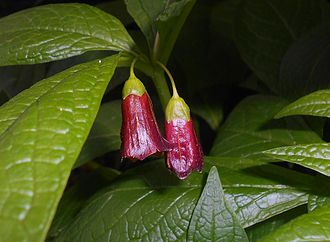Scopolia

Scopolia is a genus of four species of flowering plants in the family Solanaceae, native to Europe and Asia. The genus is named after Giovanni Scopoli (1723–88), a Tyrolean naturalist. The genus has a disjunct distribution, with two recognised species in Central to Eastern Europe, (including the Caucasus), and two species in East Asia. The two European species are:
Scopolia carniolica Jacq. of Slovenia, Austria and the Carpathian Mountains
Scopolia caucasica Kolesn. ex Kreyer of the Caucasus
and the two Asiatic species are:
Scopolia lutescens Y.N. Lee of Korea
Scopolia japonica Maxim. of Japan
The four species in the equally medicinal genus Anisodus
Anisodus tanguticus (Maxim.) Pascher
Anisodus luridus Link ex Spreng.
Anisodus carniolicoides (C.Y.Wu & C.Chen) D’Arcy & Z.Y.Zhang
Anisodus acutangulus C.Y.Wu & C.Chen
have in the past been placed in the genus Scopolia, as has the monotypic genus Atropanthe with its single species Atropanthe sinensis Pascher.[1]
Scopolia carniolica – the longest-known species and the one with the westernmost distribution – is a creeping perennial plant, with light green leaves and dull reddish-purple flowers (cream in the attractive and more ornamental variety hladnikiana, sometimes cultivated as a decorative plant). Scopolia’s extract (which contains a form of the alkaloid scopolamine) is used in at least one commercial stomach remedy (Inosea, produced by Sato Pharmaceutical). The extract is an anti-spasmodic in low doses and may be used to relax smooth muscle tissue or prevent motion-sickness induced nausea; in higher doses it is a poison having hallucinogenic and memory-inhibiting effects.
Other alkaloids found in Scopolia carniolica include cuscohygrine, hyoscyamine and atroscine.
The coumarin phenylpropanoids umbelliferone and scopoletin have been isolated from the roots of Scopolia japonica.
